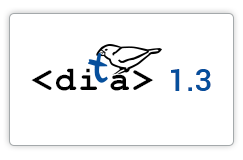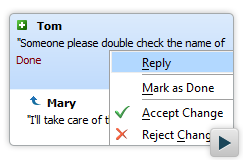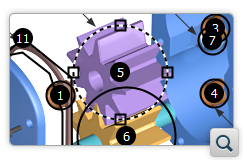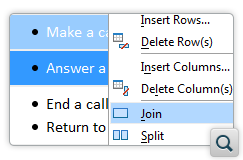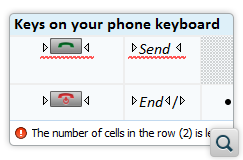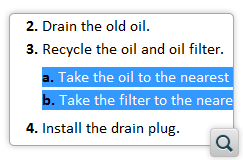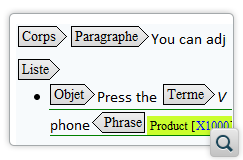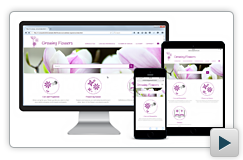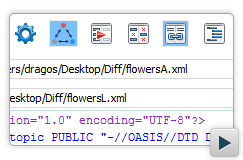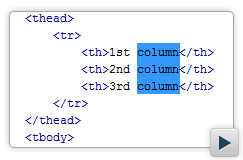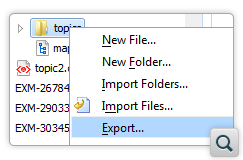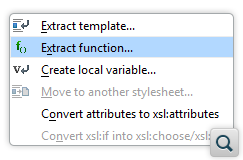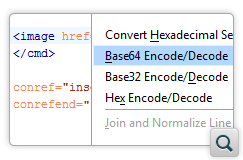Oxygen XML Editor 18.0
Oxygen XML Editor version 18.0 includes new features and improvements that set the
standards for XML authoring and developing even higher than our users are already accustomed
to.
The visual Author mode now allows you to collaborate more easily and
effectively with others through comment threads by providing a new reply to
comment action and allowing to you mark comments as being resolved.
A brand new visual Image Map Editor allows you to easily add links on
specific areas within an image, while automatically generating the corresponding
markup.
Numerous of other Author improvements have been made. Working with
tables has become more intuitive, a new validation engine reports problems in table
structures, and more Smart Paste strategies have been implemented to allow
Oxygen to preserve the validity of the document you are editing.
The new XML-aware three-way file comparison feature helps you solve
conflicts and merge changes between multiple modifications of the same file. It is
especially helpful for teams that have multiple authors working concurrently on the same
documents.
DITA content can be published using a new HTML5 publishing system called WebHelp
Responsive. Nearly all aspects of its layout can be customized and it is
adaptable to any device and screen size to provide an optimal viewing and interaction
experience. It also includes a variant that allows online users to provide feedback in your
documentation.
The most commonly used documentation frameworks, DITA and DocBook have been updated.
Oxygen now officially supports DITA 1.3 and the DITA Open Toolkit recent version 2.2.3
is offered in addition to the stable 1.8.5 version. The DocBook stylesheets were updated to
version 1.79.1 and DocBook schemas to version 5.1.
When editing in Text mode, you can use the new rectangular
selection feature to copy, cut, paste, or edit the content within the selection.
This is useful for editing or copying content inside a rectangular area that spans across
consecutive lines.
As usual, Oxygen also added many new API and component updates for this release.
There are changes in:
Visual XML Editing
Reply to Comments and Mark as Done
You can collaborate with other members of your team more easily, taking
advantage of the improved annotation support. You can now reply to comments added by
others and you can also start new comment threads. Everyone that has access to the project
can see the comment threads and join the discussion at any time. You can also resize the
callout bubbles with simple drag operations to better visualize the entire comment thread.
The Mark as done option allows you to mark a discussion thread as being
completed. This is useful for marking comments that have been addressed, leaving only
those that still need some attention.
Create and Edit Image Maps
An
Image Map Editor has been implemented in
Author mode and can be used with images in DITA, DocBook, XHTML, and
TEI documents. It allows you to add links from specific areas of an image to corresponding
topics or other resources.
Improvements for Working with Tables
When editing inside tables, the table-related actions are promoted in the
contextual menu. You can join all selected cells or split a cell on multiple rows and
columns. Multiple selection of rows is now supported so you can easily copy/paste content
from one table to another.
Report Table Layout Problems
Oxygen now reports various CALS and HTML
table layout problems using a special table validation engine. The feature is enabled by
default for DITA and DocBook documents.
Promote or Demote List Items
You can now intuitively promote or demote list items inside ordered lists or
unordered lists. The SHIFT + TAB keyboard shortcut promotes the list items,
while TAB demotes them.
Line Breaks are Preserved in Comment Callouts
When you add or edit a comment in Author mode, you can now use
line breaks and Oxygen will take the line breaks into account when presenting the
callouts in the editor or the Review view.
Line Wrapping Improved for Asian Languages
Improvements have been done to the line breaking and word wrapping in Asian
languages when editing in Author mode. For example, line breaks are now
considered before or after a Chinese Enumeration Comma.
Various Performance Improvements
Various speed improvements have been made for opening files in
Author mode both in the Oxygen standalone and the Eclipse plugin.
Speed was also improved when switching between DITA maps in the DITA Maps
Manager view.
Smart Paste Improvements
Strategies that guide you to insert content in the proper places have been
greatly improved and the best strategy is automatically applied depending on each case.
This further helps you to keep the document valid even when you are trying to insert
fragments that otherwise would invalidate the document. As an example, no matter where you
are editing in a DITA document, if you decide to add a shortdesc element,
Oxygen will insert it in its correct position and will create all its required element
structure.
Customize Rendering of Elements in Author Mode
You can
use a
configuration file to customize how element names, their icons, and their
annotations are rendered in various places in
Author mode. For example,
you can change the name that is displayed for an element in the
Content Completion
Assistant, the breadcrumb navigation bar, the
Full Tags
display mode, and the
Outline,
Elements, and
Attributes views. This is used for example by the Lightweight DITA
framework to provide user friendly names for elements,
Short Description
instead of
shortdesc,
Definition List instead of
dl and
so on.
HiDPI Improvements on Windows and Linux
Various improvements and fixes have been made to make the application
compatible with HiDPI monitors on Windows and Linux.
DITA
DITA 1.3 Official Support
DITA 1.3 specification is officially supported and enabled by default. Previous
DITA versions are also supported.
Content Completion Assistance Improvements
When inserting or editing the conkeyref attribute in DITA, the
content completion assistance will propose a list of keys that are defined in the DITA map
and the trailing slash will be automatically inserted.
DITA Open Toolkit 2.2.3
Updated the bundled DITA Open Toolkit to version 2.2.3 in addition to providing
also the stable DITA-OT 1.8.5.
DITA-OT Markdown Plugin Integration
The
DITA-OT Markdown plugin has been added to the DITA Open Toolkit
2.x distribution that come bundled with Oxygen. It allows you to publish DITA content
to
Markdown, or to publish DITA Maps that refer to
Markdown resources.
DITA Map to WebHelp Responsive Transformation Scenario
A new online help publishing system called WebHelp Responsive is now available.
The system has the ability to adapt to any device and screen size to provide an optimal
viewing and interaction experience. It is based upon the Bootstrap responsive front-end
framework. Oxygen includes a variety of predefined templates and skins for this new
WebHelp system and you can customize the output according to your needs. It also includes
a feedback mechanism that allows online users to post comments on each topic from the
manual.
Special Support for Editing Lightweight DITA
A new framework for Lightweight DITA provides specialized support for
lightweight DITA topics and maps, featuring guided authoring concepts like inline hints
and actions as well as form controls for editing different properties directly within the
editing area.
DITA Map to PDF WYSIWYG Transformation Improvements
Various fixes and improvements were also added to the DITA Map to PDF WYSIWYG
transformation. The output now shows chapter numbers, supports tables with cells that span
multiple rows or columns, and if you enable the show.changes.and.comments
parameter, replies to comments will also now be presented in the output, along with
comments and tracked changes.
DocBook
Improved Annotations of DocBook Elements
The annotations that appear when you hover over elements in DocBook documents
have been improved to include the name of the element, a brief description, and a link to
the specification.
DocBook XSL Version 1.79.1
Updated DocBook XSL to the latest version 1.79.1.
DocBook 5.1 Schemas
The DocBook schemas were updated to the latest version 5.1.
XML Refactoring
Custom XML Refactoring Operations
You can create your own custom XML refactoring operations and share them with
other team members. These custom operations are now supported in all editions of
Oxygen.
CSS
Improvements to Content Completion in CSS
When entering CSS selectors in the CSS editor, the Content
Completion Assistant will now offer a list of pseudo-elements and pseudo-classes that are
available for the particular CSS profile. Also, after @media or
@import rules, it will now offer a list of supported media
types.
Shortcut to Open Resources in CSS Files
When editing CSS or LESS stylesheets, you can now quickly open imported
stylesheets or other resources (such as images) in the default system application for the
particular type of resource, using a new shortcut (Ctrl+Single-Click or
Command+Single-Click on OS X).
Support for the rem Length Unit
Support was added for the rem font size unit. It can be used
as a unit of measurement for the <length> value of a 'font-size'
property and it refers to the initial value of the 'font-size' property
of the root element.
Content Completion
Customization of Content Completion Proposals
The elements and attributes that are proposed in the Content Completion
Assistant
can be customized for each framework by using a configuration file. You can
configure the values that are proposed, customize the elements or attributes that are
proposed, or specify a global list of elements or attributes that will be available for a
particular framework.
Quick Search in the Content Completion Proposals List
When entering a search string in the Content Completion
Assistant, it presents proposals that start with the prefix entered
as the search string, followed by items that contain the search string. For
example, in an XML document, if you enter 'list', the Content
Completion Assistant will propose 'list' and
'orderedlist'. Note that for the Oxygen Eclipse plugin, this
feature is only available in Author mode.
Schemas
Multi-Lingual Support in Schematron Validation Messages
You can now specify a language to be used for Schematron validation messages
with an option in the Schematron preferences page and they can be
presented in multiple languages by defining the language for each message using Schematron
diagnostics.
File Comparison Tool
Three-Way File Comparison Support
A three-way file comparison feature was added to the file
comparison tool to help you solve conflicts and merge changes between multiple
modifications. It is especially helpful for teams who have multiple authors editing and
committing the same documents. It provides a comparison between a local change, a remote
change, and the base (ancestor) revision.
Multiple Algorithms for Three-Way Comparisons
You can use Lines, XML Fast, and XML
Accurate algorithms for the three-way comparison feature in the file
comparison tool and in the Compare view in Syncro SVN
Client.
Second-Level Comparison
The File Comparison tool now automatically performs a second
level comparison for the Lines, XML Fast, and
XML Accurate algorithms. After the first comparison is finished, the
second level comparisons are processed on text nodes using a word level comparison,
meaning that it looks for identical words. This second level comparison makes it easier to
spot precise differences and you can merge or reject the precise
modifications.
Ignore Nodes by XPath Option
A new option was added on the toolbar of the File Comparison
tool and in the Compare view in the Syncro SVN Client. You can enter an
XPath 2.0 expression to ignore certain nodes when comparing using the XML
Fast or XML Accurate algorithms.
API
A detailed list of all changes to the Java API can be found
here.
Present Specialized Dialog Box when Double-Clicking a Tag
The
EditPropertiesHandler interface allows you to present a specialized dialog box
when the action of double-clicking an element tag is intercepted. For example, you could
use it to present a dialog box that allows the user to editing the properties of an image.
Notification of Batch Close Operations
Notification when a Document Type is Reconfigured
API to Perform Manual or Automatic Validation
Customize Tooltips in Author Mode
Select and Scroll to a Selection in Author Mode
Make Opened Resource Read-Only
Launch File Comparison Tool for Two URLs
Access to Review Actions from DITA Maps Manager
Get or Set Values of Global Options
The
GlobalOptionsStorage API allows you to get or set the values of certain global
options in Oxygen.
Add Custom Actions to the Menu Shortcut Keys Preferences Page
The
ActionsProvider.registerAction API allows you to register a new action in the
application and the action will be added to the list in the
Menu Shortcut
Keys options page. Thus, you can assign a shortcut key to the new action either
via the API or from the
Menu Shortcut Keys Preferences
page.
Install a Custom Image Handler
Notification when Oxygen Eclipse Plugin Starts
The EclipseWorkspaceAccessPluginExtension plugin extension point can be used to
notify another plugin when the Oxygen Eclipse plugin is started or before it is
closed. The other plugin can use the API, for example, to add or remove various
listeners.
Access Parent Editor from any Mode
Customize Pop-ups, Menus, and Toolbars from a Single Implementation
Intercept Action Events in Author Mode
The
AuthorActionEventHandler API allows you to intercept special action events (TAB,
SHIFT-TAB or ENTER) in the
Author mode and then you can handle them in a
special manner.
Image Decorator in Author Mode
The new
AuthorImageDecorator API allows you to decorate images that are displayed in the
Author mode. For example, you could use it to add a message over an
image informing the user that they can double-click the image to edit it.
Retrieve Callout Header Information in Author Mode
Choose Possible Parent Elements Used in the Smart Paste Feature
The
AuthorSchemaAwareEditingHandlerAdapter.getAncestorDetectionOptions method was
added. When pasting content in
Author mode, if the result causes the
document to become invalid, the
Smart Paste feature will propose
solutions to make it valid. As a possible solution, Oxygen might surround the pasted
content in a sequence of ancestor elements. This new API method allows you to choose which
parent elements might be a possible solution.
Smart Paste Feature will Replace Empty Node
The
AuthorSchemaAwareEditingHandlerAdapter.canBeReplaced method
was added to improve solutions for the Smart Paste feature. For example, when pasting an
element inside an empty element with the same name, Oxygen might replace the empty
node with the new one. The callback could also reject this behavior if, for instance, the
replacement node contains attributes.
Other
Upgraded Support for EAD 3.0
Support for creating, editing, and validating Encoded Archival Description
(EAD) documents has been updated to include version 3.0.
Special Improvements for Comparing JSON Files
When using the Compare Files tool on two JSON files, the
Format and Indent action will automatically sort the keys in both files
to make it easier to compare the files.
HTML5 Content Completion Support in XSLT
HTML5 elements (such as video and canvas) are
included in the proposals offered by the Content Completion Assistant for XSL
files.
Wildcards Allowed in Resource Names
When configuring a list of libraries in the document type associations
(frameworks) or in the list of libraries associated to an ANT or DITA OT transformation
scenario, the library file names can be specified using wildcards (for example,
${framework}/lib/*.jar).
Rectangular Selection
A new rectangular selection feature allows you to edit, copy, cut, paste, or
delete content in Text mode. This is useful for managing content inside a
rectangular area that spans across consecutive lines.
Print Line Numbers
If line numbers are displayed in the Text mode editor, you now
have the option to include them in the printed output.
Print Selected Text
You now have the ability to print a selection of text rather than the entire
document. When you invoke the print action with a block of content selected, a dialog box
will be presented that offers you the choice to print the selection or the entire
document.
Print Folded Document
You can now print XML documents that are opened in Text mode
in their folded state. This applies to printing an entire document and
not selections within a document.
Export Database Resources
A new contextual menu action (Export) in the Data
Source Explorer view allows you to export the folder on the remote connection
to a local folder. This applies to WebDAV, SharePoint, Documentum, Berkeley, MarkLogic,
and eXist connections.
Option to Clear History in Various Drop-Down Menus
Various drop-down menus now have a Clear History option at the
bottom of the list. As the name implies, it allows you to clear the history of your past
selections in the particular drop-down menu.
Added More Refactoring Actions for XSLT Stylesheets
When editing XSLT documents, some actions were added to the
Refactoring submenu (available from the contextual menu or
Document menu). The Extract Function action extracts a
selected XSLT instructions sequence into a new function. Also, the Create Local
Variable action creates an XSLT variable, wrapped around the
selection.
Encode/Decode Base 64, Base 32, and Hex Encoding Schemes
Some actions were added to the contextual menu in Text mode
that allow you to decode or encode content. The actions are available for Base
64, Base 32, and Hex encoding/decoding
schemes. This is especially helpful for testing SOAP requests when responses are encoded
in a particular scheme.
Improvements for Editing JSON Documents
You now have the possibility of running XPath expressions when editing JSON
documents and they can be mapped in the Grid editing mode.
Support for Installing Saxon 9.7 as an Add-on
Even though Saxon 9.7 does not come bundled with Oxygen, you can install it
as an add-on. This external transformer can be used for XSLT and XQuery transformation and
validation scenarios.
Component Updates
EpubCheck 4.0.1
Support for EpubCheck was updated to version 4.0.1.
Apache FOP PDF Generation Library
Updated Apache FOP PDF generation library to version 2.1.
Apache XML Graphics Commons 2.1
Updated Apache XML Graphics Commons to the latest version, 2.1.
JIDE 3.6.12
The JIDE library was updated to version 3.6.12.
Batik SVG Rendering Library 1.8
Updated Batik SVG rendering library to version 1.8.
TEI Schema 3.0.0
Updated TEI Schema to version 3.0.0.
TEI XSL 7.41.0
Updated TEI XSL stylesheets version to 7.41.0.
HttpClient 4.5.1
Updated the HttpClient library and its dependencies to version
4.5.1.
